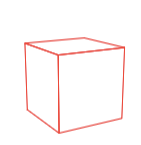I want to see a wireframe of an object without the diagonals like
Currently, I add lines according to the vertices, the problem is after I have several of those I experience a major performance degradation.
The examples here are either too new for my version of Three or don't work (I commented there about it).
So I want to try to implement a shader instead.
I tried to use this shader: https://mcmap.net/q/413639/-display-wireframe-and-solid-color but it breaks the shape to parts and I'm getting WebGL errors.
That's how I use it:
const vertexShader = `
varying vec2 vUv;
void main() {
vUv = uv;
gl_Position = projectionMatrix * modelViewMatrix * vec4(position,1.0);
}
`
const fragmentShader = `
#version 150 compatibility
flat in float diffuse;
flat in float specular;
flat in vec3 edge_mask;
in vec2 bary;
uniform float mesh_width = 1.0;
uniform vec3 mesh_color = vec3(0.0, 0.0, 0.0);
uniform bool lighting = true;
out vec4 frag_color ;
float edge_factor(){
vec3 bary3 = vec3(bary.x, bary.y, 1.0 - bary.x - bary.y);
vec3 d = fwidth(bary3);
vec3 a3 = smoothstep(vec3(0.0, 0.0, 0.0), d * mesh_width, bary3);
a3 = vec3(1.0, 1.0, 1.0) - edge_mask + edge_mask * a3;
return min(min(a3.x, a3.y), a3.z);
}
void main() {
float s = (lighting && gl_FrontFacing) ? 1.0 : -1.0;
vec4 Kdiff = gl_FrontFacing ?
gl_FrontMaterial.diffuse : gl_BackMaterial.diffuse;
float sdiffuse = s * diffuse;
vec4 result = vec4(0.1, 0.1, 0.1, 1.0);
if (sdiffuse > 0.0) {
result += sdiffuse * Kdiff +
specular * gl_FrontMaterial.specular;
}
frag_color = (mesh_width != 0.0) ?
mix(vec4(mesh_color, 1.0), result, edge_factor()) :
result;
}`
...
const uniforms = {
color: {
value: new THREE.Vector4(0, 0, 1, 1),
type: 'v4'
}
}
const material = new THREE.ShaderMaterial({
fragmentShader: data.fragmentShader,
vertexShader: data.vertexShader,
uniforms
})
this._viewer.impl.matman().addMaterial(
data.name, material, true)
const fragList = this._viewer.model.getFragmentList()
this.toArray(fragIds).forEach((fragId) => {
fragList.setMaterial(fragId, material)
})
So to implement this shader, is the right approach would be to basically check the angle between every two vertices, and draw a line if the degree is 90?
How can I have access to all the vertices of the shape from the vertex shader?
And how can I tell the fragment shader to draw a line between two vertices that match the above condition? (also to leave the default shading for everything else as is)
I'm using Autodesk viewer that uses Three.js rev 71.



#version 150 compatibilityis not valid WebGL GLSL. Your shader is not compiling successfully and therefore you're getting errors related to a bad shader. These lines as wellflat in float diffuse;are also WebGL2 only – Unknown